Standard Observation Seaplane
Aviazione Ausiliaria per la Regia Marina 454 built 1934-43

The CANT Z.501 Gabbiano (“Gull”) was a high-wing central-hull flying boat with a single pusher engine whch first flew in 1934 (setting a world distance record) and was produced to 454 until 1943. It served with the Aviazione Ausiliaria per la Regia Marina, a branch of the Regia Aeronautica in WW2 as main reconnaissance model. Obsolete by 1940, the CANT Z501 Gabbiano was gradually replaced by the CANT Z506 Airone. It was still used however until 1945, taking many losses, the last being retired in 1950. It was also used by Spain and Romania.
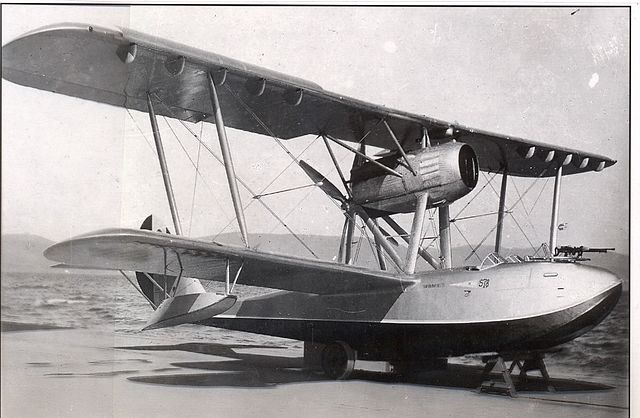
The previous SM 78, the Gabbiano was supposed to replace. This was still recent, having first flight in 1932, in service by 1933, 49 being delivered. It derived from the previous Savoia-Marchetti S.62 but with a more powerful engine, modified wings and became a reconnaissance and maritime bomber, and last biplane in this role. Performance were not stellar, which pushed the RN to want to replace it asap after just a year into service. The last still flew in WW2 for sea rescue.
Development: Balbo and Zapatta
Development of the CANT Z501 Gabbiano started under the guise of Filippo Zappata, a great Italian aircraft designer which started with Cantieri Aeronautici e Navali Triestini (CANT) but later moved to France by 1927, working for aviation pioneer Blériot. However Italo Balbo pleaded with him for a return, that he did, resuming work at CANT on a new generation of aircraft for the Regia Aeronautica. His first new design for CANT was precisely the Z.501. It was called for a replacement to the replacement of the Savoia-Marchetti S.78. Breda would become famous later with the Z.1007 Alcone bomber, Agusta A101 helicopter and Breda BZ-308 airliner.
Balbo was at the head of the Regia Aeronautica, knew the engineer’s work well, and ordered him a new seaplane for reconnaissance and surveillance missions, more modern and faster than the previous SM.78, in service for short already.
Balbo then created a team with the best engineers at the time inside CRDA CANT ro assist Zappata, which had to work around the closk to realize this new project. Engineers had carte blanche, still for technical details and general configuration, the only constraint being it to be a single-engine flying boat. Zappata argued that a twin-engine (given the weak power obtained from Italian engines at the time), but orders for a single engine model came from much higher up.
Chief engineer set its scope on the available Isotta Fraschini Asso XI, a V12 initially developed for a Schenider cup racing seaplane which was cancelled. This engine developed 800 horsepower and engineers from Isotta precised they could be able to “inflate” it more as they did for the Asso XI-RC. A 10% gain was asked for.
Zappata then started from this engine and developed a military flying boat in line with developments at the time: The CANT Z501 would had a parasol single wing, a double-stepped hull, an enclosed cockpit, as well as front and back MG defensive posts in open air as additional floats. As the design progressed, one engineer came up with the idea of having a third MG post… placed on the back of the engine’s fairing. Also not to hit hard limited metal resources, already much in demand, his seaplane was designed to be entirely made of plywood and several other wood essences. It was named CRDA – CANT Z501 Gabbiano (gull). The name seemed appropriate for a model destined to the Regia Marina.
Setting world records
The prototype first flew in February 1934, under hands of test pilot Mario Stoppani. It looked promising. The Z501 even outdone its original specifications, not official but from the engineering team itself. It was so good as to be heralded by fascist propaganda, and soon showcased in many record flights, above the North Atlantic and Mediterranean. A few weeks after its maiden flight, it took off in May 1934, for an historic, record flight of 4,135 kilometers, between northeastern Italy and Eritrea, an Italian colony. This flight was made in 26 hours.
The production CANT Z501 Gabbiano in fact had an amazing endurance of 12 hours, covering an immense area. The record-breaking version, greatly exceeded this as it was stripped of all non-essentials, but filled to the brim with extra fuel. The USA set the trend, blasting 3,860 km (2,400 mi) with another model until Mussolini, having heard of the Z.501 wanted a modified model (civilian registration I-AGIL) to re-take this record. It was piloted by Stoppani with two replmacement pilots for the long trip. It was also fitted with a special metal three-blade propeller and many other modifications.
On 19–20 May 1934, the distance of 4,130 km (2,570 mi) was reached, from Monfalcone to Massawa (Eritrea), was crossed by a modified CANT Z501 Gabbiano in 26 hours and 35 minutes, non stop. Soon however a French aircraft flew 4,335 km (2,694 mi) on 23 June, so the Italians planned another record flight on 16 July, this time to Djibouti at 4,700 km (2,900 mi). Instead it flew 4,930 km (3,060 mi) to Berbera in Italian Somaliland, over 25 hours at low speed to limit consumption again.
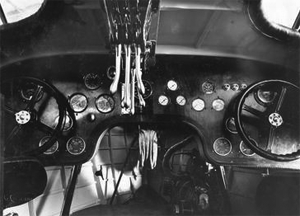 Despite these success in the world of aviation and the press, the company had no cutomers apart the Regia Aeronautica. In 1935 it was even offered to the Luftwaffe, but the latter choose instead the Dornier Do-15 and very promising Do-18 under development. The Regia Aeronautica ordered a first batch of 100, then it was soon doubled to 208, far more than the previous SM.78. Trust in the new design was huge. The slower SM.78 for example had a range of 2,400 km (1,500 mi, 1,300 nmi) and 11.5 hours. The Z501 was about the same at 2,398 km (1,490 mi, 1,295 nmi).
Despite these success in the world of aviation and the press, the company had no cutomers apart the Regia Aeronautica. In 1935 it was even offered to the Luftwaffe, but the latter choose instead the Dornier Do-15 and very promising Do-18 under development. The Regia Aeronautica ordered a first batch of 100, then it was soon doubled to 208, far more than the previous SM.78. Trust in the new design was huge. The slower SM.78 for example had a range of 2,400 km (1,500 mi, 1,300 nmi) and 11.5 hours. The Z501 was about the same at 2,398 km (1,490 mi, 1,295 nmi).
Little did their knew that despite its good range and armament, the Gabbiano had very serious issues, but they would only appear while in service.
Design of the class
Fuselage and general design
It had a very slim fuselage, high parasol thick wing (acting as fuel tank) and a single wing-mounted engine nacelle. The prototype was fitted with a 560 kW (750 hp) liquid-cooled inline Isotta Fraschini Asso-750.R and annular radiator. So despite it was a V12, it looked like a radial. The engine nacelle was extended aft, so to house a rear-facing flexible mounted light machine gun. The two other, with mixed arc of fire, were located at the centre of the fuselage and nose. The aerodynamics and lightweight structure, between the low-drag typical of Zappata designs and wooden construction freed the 880 hp engine to express itself. In 1935-36 the top speed of 275 km/h for an observation seaplane was reasonable.
Wings and tails layout
The wings, tail and ailerons had a nice elliptic design, all the shapes were meticulously shaped for the lowest drag possible, even the fuselage shape, both seen from above of profile had natural-looking elliptic shapes. This made for a model that undoubtely “looked right” as said at the time, with considerable aesthetics despite its ingrate role as flying boats. The ailerons were compensated, trimmed, and wired, held in place. The same X type wiring went to the attachement of both the main engine nacelle and wings to the fuselage with two sets of V type struts and intermediate reinforcements. Other sets of tranverse and lateral X type struts supported the external wing section to the fuselage.
Powerplant
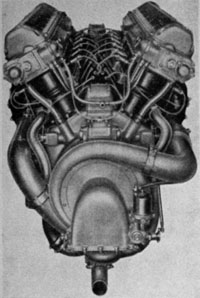 The production model flew with a ring radiator in front of a water cooled Isotta Fraschini Asso XI R.2C.15 engine rated at 656 kW (880 hp). It was tracting a 3-bladed metal prop, so the model was not a pusher, a solution often seen on similar parasol and biplanes floatplanes. The contemporary Loire 130 was comparable for example (although smaller and shaped like a brick in comparison) but a pusher. The Asso XI was a reliable and powerful engine which also found its way on the CANT Z.505, Z.508, Z.1007 and Z.1011 as well as Caproni, IMAM, Paggio, Ambrosini and Savoia-Marchetti models.
The production model flew with a ring radiator in front of a water cooled Isotta Fraschini Asso XI R.2C.15 engine rated at 656 kW (880 hp). It was tracting a 3-bladed metal prop, so the model was not a pusher, a solution often seen on similar parasol and biplanes floatplanes. The contemporary Loire 130 was comparable for example (although smaller and shaped like a brick in comparison) but a pusher. The Asso XI was a reliable and powerful engine which also found its way on the CANT Z.505, Z.508, Z.1007 and Z.1011 as well as Caproni, IMAM, Paggio, Ambrosini and Savoia-Marchetti models.
The RC40 for example had its 12-cylinder supercharged water-cooled which piston were at a 60° Vee (Bore 146 mm, stroke 160 mm) and displaced 32.65 L (1,992 cu in) for a dry weight of 594 kg (1,310 lb).
Armament
The three gun positions were each given a 7.7 mm (.303 in) Breda-SAFAT machine gun, replacing the original Vickers. The early models had an open position, which was partially enclosed in a glassed turret, yet still open top on the later models. There was a limited Bomb load carried by the CANT Z501 Gabbiano, reaching 640 kg/1,410 lb in the shape of four 160 kg/350 lb bombs carried under the wings.
Production
Production of the CANT Z501 Gabbiano started in 1935 with 24 ordered as preserie from CANT, and 30 from Aeronautica Sicula (a company in Palermo). Registration numbers started with MM.35168. In all, 454 were manufactured, which was a considerable undertaking by the Italian industry, the runnup going up to 1943 and the Italian capitulation in September. There never was a true replacement in her role operational in time, the only one designed being the Z.515.
Planned replacement: CANT Z515
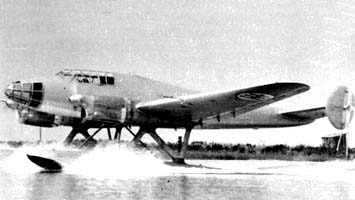 The Z.515 was planned in 1938, designed by Zapatta as a cantilever low wing monoplane, with straight tapered wings (and with dihedral), rounded tips. This time, Zapatta had its way to have installed two engines, this time the modern 560 kW (750 hp) V-12 Isotta-Fraschini Delta, well forward of the leading edge. Still very aerodynamic, with a low-mounted wing and twin tail aft, this model was very different from the Z.501. Its lower part was completely glazed and there was a long cockpit forward of the wing leading edge, low dorsal MG turret and three more posts. It could carry just abot the same amount of bombs, 600 kg (1,320 lb). It first flew in 1939, further developled and flew again on 8-9 July 1940 the Regia Aeronautica ordering 64 in 1941 with, 50 from Aeronautica Sicula but given the highly strained Italian industry at the time, only ten were ever completed. It will be the object of a post in the near future.
The Z.515 was planned in 1938, designed by Zapatta as a cantilever low wing monoplane, with straight tapered wings (and with dihedral), rounded tips. This time, Zapatta had its way to have installed two engines, this time the modern 560 kW (750 hp) V-12 Isotta-Fraschini Delta, well forward of the leading edge. Still very aerodynamic, with a low-mounted wing and twin tail aft, this model was very different from the Z.501. Its lower part was completely glazed and there was a long cockpit forward of the wing leading edge, low dorsal MG turret and three more posts. It could carry just abot the same amount of bombs, 600 kg (1,320 lb). It first flew in 1939, further developled and flew again on 8-9 July 1940 the Regia Aeronautica ordering 64 in 1941 with, 50 from Aeronautica Sicula but given the highly strained Italian industry at the time, only ten were ever completed. It will be the object of a post in the near future.
⚙ CANT Z501 Gabbiano specifications |
|
| Gross Weight | 3,850 kg (8,488 lb) |
| Max Takeoff weight | Max takeoff weight: 7,050 kg (15,543 lb) |
| Lenght | 14.3 m (46 ft 11 in) |
| Wingspan | 22.5 m (73 ft 10 in) |
| Height | 4.4 m (14 ft 5 in) |
| Wing Area | 62.00 m2 (667.4 sq ft) |
| Engine | Isotta Fraschini Asso XI R.2C.15 , 656 kW (880 hp) +3-bladed metal prop. |
| Top Speed, sea level | |
| Cruise Speed | 240 km/h (150 mph, 130 kn) at 1,999 m (6,560 ft) |
| Range | 999 km (621 mi, 539 nmi), ferry: 2,398 km (1,490 mi, 1,295 nmi) |
| Climb Rate | ? |
| Ceiling | ? |
| Armament | 3 × 7.7 mm (0.303 in) Breda-SAFAT LMGs, 640 kg (1,400 lb) bombs |
| Crew | 4-5: Pilot, radio/co-pilot, 3 MG gunners. |
The CANT Z501 Gabbiano in service: Mussolini’s will

Gabbianos promoted in a LUCE film.
In 1936, the Z.501 entered service, was received by numerous units, and by the end of the year, a worrying numbers of issues were signalled (see later).
It was of course deployed with many coastal units managed by the Aviazione Ausiliaria per la Regia Marina, proving Mussolini’s point his “unsinkable aircraft carrier Italy” could reach any point of the Mediterranean, or rather “mare nostrum”. The reality was far less rosy and it’s only under the indistance of the Duce that the flawed model saw its construction going on to the last.
The first combat seen by the CANT Z501 Gabbiano was the Italian intervention in Spain, Mussolini deciding to sent to support Franco some ten Z.501s. They were equipped as bombers and promoted as such. He even sent his own film crew to document their use. Their first mission saw a lack in reported precision, but still, they became instrumental for monitoring the whole Spanish coastline. In January 1939, one caused an incident with France, as it was interecepted, allegedly after violating French airspace. Two French Morane-Saulnier MS.406 fighters opened fire to force it to land near Biarritz where it was confiscated, tested by official French services (which were not impressed). The crew was arrested and sent back to Spain in the spring of 1939 as the civil war was over.
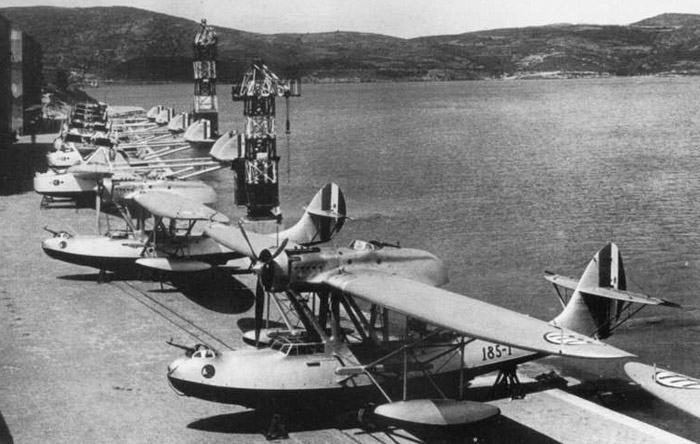
Z501 in a naval base in wartime (used for SAR) alongside Sm.74s.
As the war started in 1940, replacement of the CANT Z501 Gabbiano already was there; The A.A. per la RM. already trying to replace the Gabbiano in their first line reconnaissance squadrons by a moder modern model, the excellent Z.506 Airone. The latter has been designed rather for transport and a torpedo carrier, and on principle use to attack allied shipping. But the situation was so dire, unsatisfaction was such with the Z.501 relegated to coastal surveillance duties, that the already hard-pressed Airone was used instead when possible. The majority still, remained in service, fault or any replacement. In 1941, however the RN choosed to passed these on to axis, notably the Romanian Royal Air Force.
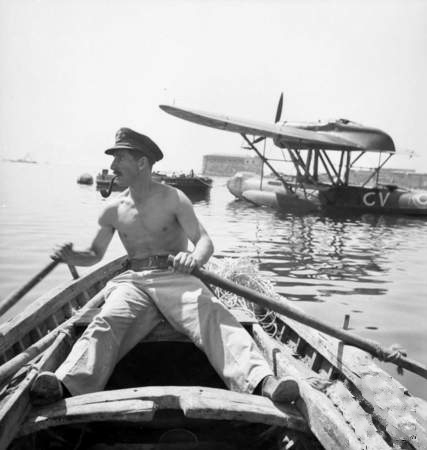
A captured CANT Z501 Gabbiano at Augusta in 1943, tested by the RAAF.
Meanwhile crews of the Regia Aeronautica had to make due with what was a real nightmare, to the point defection became a real occurence. The British recovered one such model by the end of 1940 in Malta. Like the French, they tested it, and weren’t impressed to say the least. They reported it slow, unstable, poorly armed, unwieldy, unsafe, sluggish and weakly built. They criticized in particular the upper nacelle machine gun. The Royal Air Force however saw how its pilots could deal with it easily. And indeed, a large portion of the Z.501s were short down around the Mediterranean. Malta’s puny air force for example while on patrol shot down many.
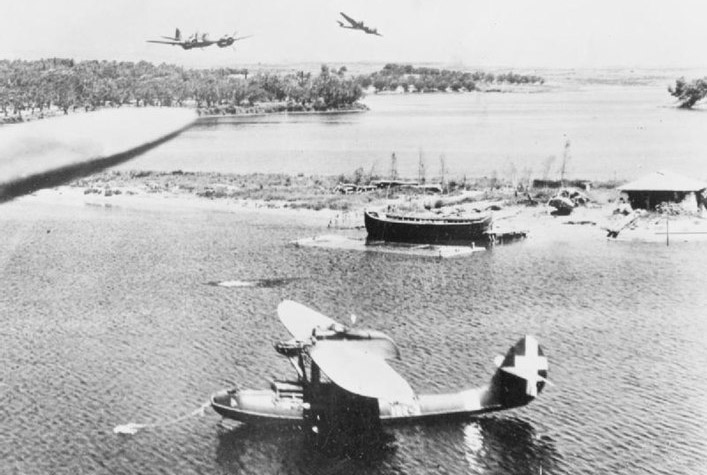
CANT Z501 Gabbiano at Preveza under attack in 1943 by Bristol Beaufighters.
The armistice of 1943 put an end to the fighting and a partition, some Z.501 Gabbiano entering cobelligerence, fiughting alongside the Allies to the end despite their poor performances, but mainly in less risky roles of sea search and rescue. Even less were used by the RSI in the north. The Germans also captired some, tested these and quickly deduced they would be better as decoys and harbour fodder for allied bombings, hiding their own floatplanes nearby, with success.
In the spring of 1945 there were still about 40 CRDA–CANT Z.501 still in flying condition. The Aeronautica Militare Italiana maintaind them, cannibalizing others to keep them operational for coastal reconnaissance but also search and rescue well after the end of the war. They were aslo used for sea mine search missions, a vital role to free harbours and lanes, resuming trade. They operated unarmed which spared some extra weight. But the problems were still there, albeit many had bee remedied and pilots now more experienced with all their issues. The last were retired in 1950.
A bird plagued with issues
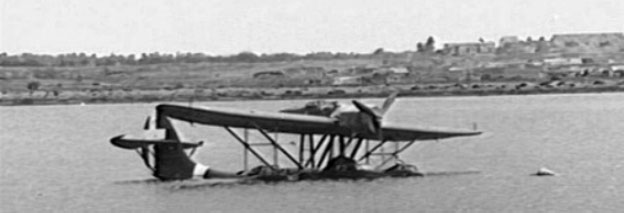
CANT Z501 Gabbiano sinking in Benghazi.
Pilots found the CANT Z501 Gabbiano slow, defeaningly noisy (especially for the engine nacelle gunner, which could not communicate with the rest of the crew or even insde the cockpit. In addition, and contrary to the prototypes and record model, with all military additions made for practical service, it became sluggish, difficult to pilot, and the wooden structure proved not to be waterproof. When in water, it started to flood enough for the pilots to want to be as close as the shore as possible to beach it. The placement of the propeller also was a major issue as it was well able to decapitate both the pilot and copilots in a hard landing… A good reason why keeping the engine in a pusher configuration (as with seawater spray corrosion).
Despite these defects, “Il Duce” persisted to see its holder of four world records to be in service anyway, despite all warnings of officers, which asked for the cancellation of orders and retirement. Despite of all this, the CANT Z501 Gabbiano soldiered on for… fifteen years. Basically it was only due to the insistence of Mussolini, exactly like for another land-bird, the mediocre Breda Lince. Only him could force his pilots to continue operating what was now considered as a hinderance in operations.
Read More/Src
Links on the CANT Z501 Gabbiano
en.wikipedia.org/
on it.wikipedia.org/
avionslegendaires.net/
on militaryfactory.com/
aviastar.org
airpages.ru
commons.wikimedia.org/ CANT_Z.501_Gabbiano
http://www.adf-serials.com.au/cant501.htm
Videos
Model Kits
General query on scalemates and this query.
Despite its shortcomings, the Gabbiano was a pleasing seabird, but only covered by Italeri and Revell a 1:72 scale, but also LF Models and Tauro models.
3D
Gallery on the CANT Z501 Gabbiano
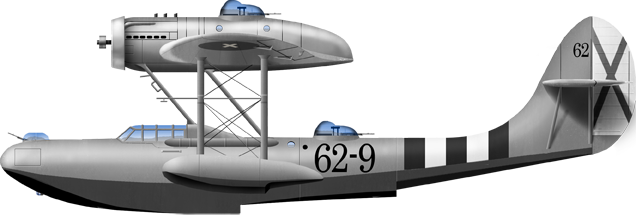
Model of the Grupo 62 of the Spanish Nationalist Forces, 1937

Model of the 141 Squadriglia La Spezia, July 1940

Model of the 189 Squadrigilia, Augusta, late 1942

Romanian Navy CANT Z501 in Costanza harbour, 1943
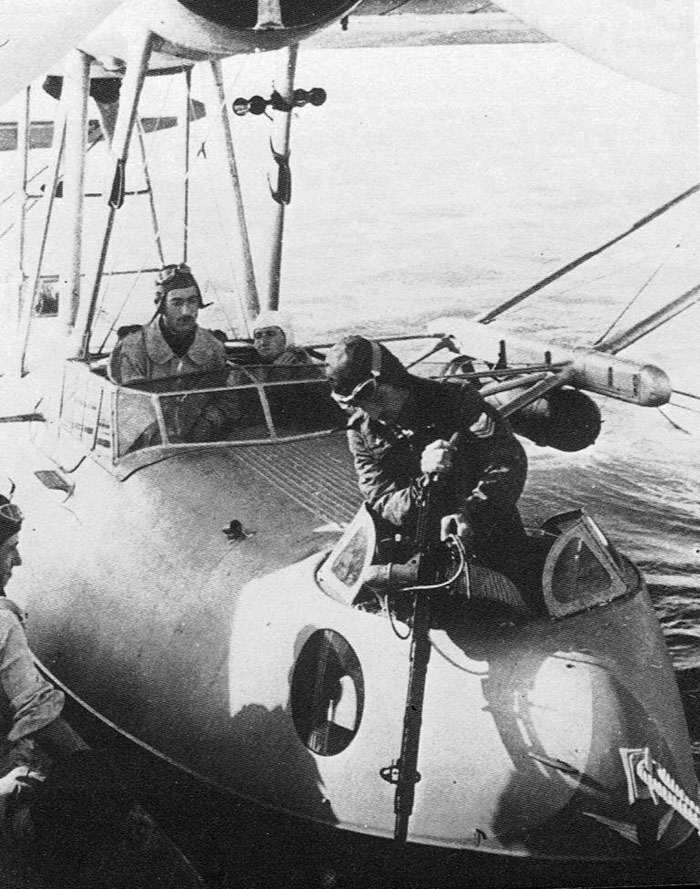
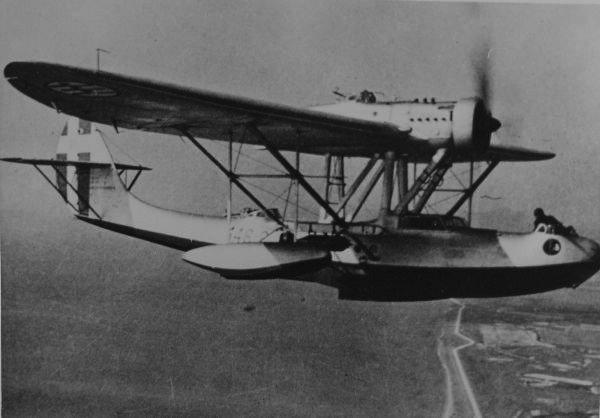
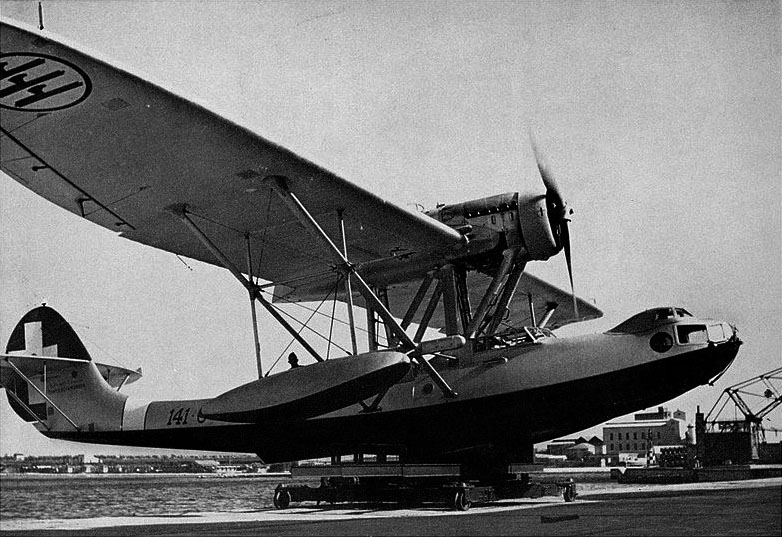
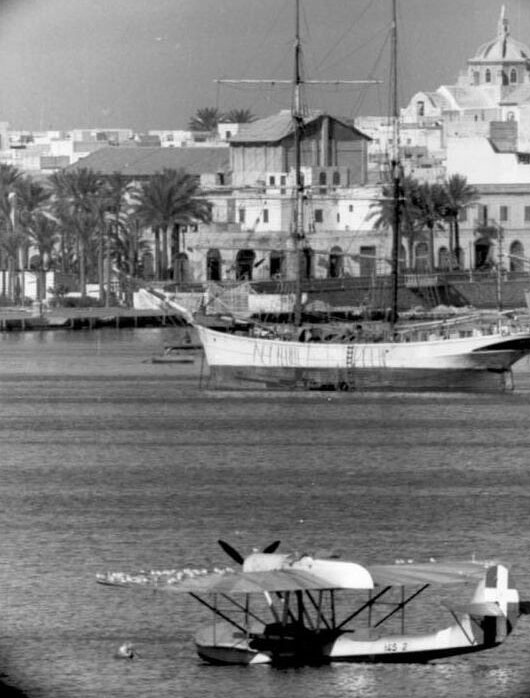

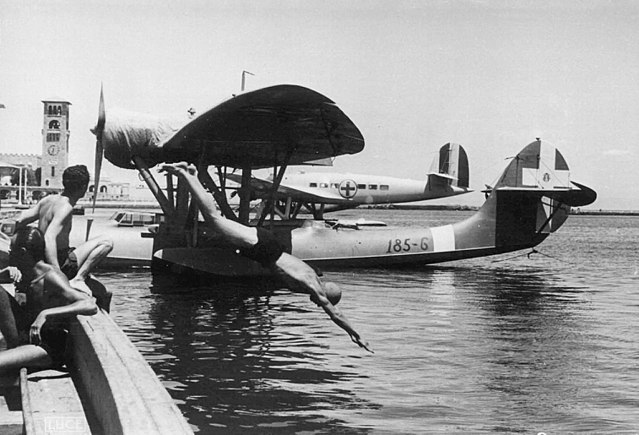

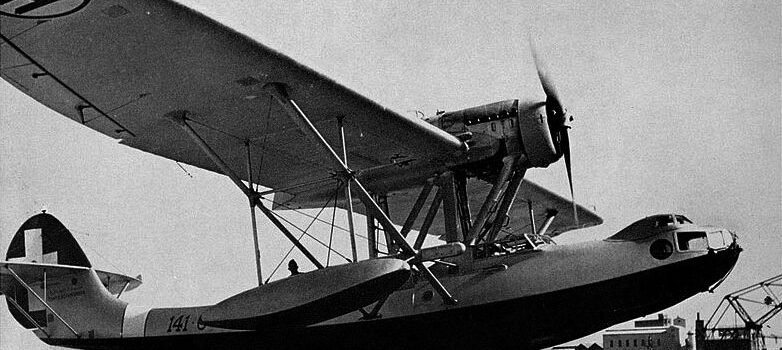
 Latest Facebook Entry -
Latest Facebook Entry -  X(Tweeter) Naval Encyclopedia's deck archive
X(Tweeter) Naval Encyclopedia's deck archive Instagram (@navalencyc)
Instagram (@navalencyc)





 French Navy
French Navy Royal Navy
Royal Navy Russian Navy
Russian Navy Armada Espanola
Armada Espanola Austrian Navy
Austrian Navy K.u.K. Kriegsmarine
K.u.K. Kriegsmarine Dansk Marine
Dansk Marine Nautiko Hellenon
Nautiko Hellenon Koninklije Marine 1870
Koninklije Marine 1870 Marinha do Brasil
Marinha do Brasil Osmanlı Donanması
Osmanlı Donanması Marina Do Peru
Marina Do Peru Marinha do Portugal
Marinha do Portugal Regia Marina 1870
Regia Marina 1870 Nihhon Kaigun 1870
Nihhon Kaigun 1870 Preußische Marine 1870
Preußische Marine 1870 Russkiy Flot 1870
Russkiy Flot 1870 Svenska marinen
Svenska marinen Søværnet
Søværnet Union Navy
Union Navy Confederate Navy
Confederate Navy Armada de Argentina
Armada de Argentina Imperial Chinese Navy
Imperial Chinese Navy Marinha do Portugal
Marinha do Portugal Mexico
Mexico Kaiserliche Marine
Kaiserliche Marine 1898 US Navy
1898 US Navy Sovietskiy Flot
Sovietskiy Flot Royal Canadian Navy
Royal Canadian Navy Royal Australian Navy
Royal Australian Navy RNZN Fleet
RNZN Fleet Chinese Navy 1937
Chinese Navy 1937 Kriegsmarine
Kriegsmarine Chilean Navy
Chilean Navy Danish Navy
Danish Navy Finnish Navy
Finnish Navy Hellenic Navy
Hellenic Navy Polish Navy
Polish Navy Romanian Navy
Romanian Navy Turkish Navy
Turkish Navy Royal Yugoslav Navy
Royal Yugoslav Navy Royal Thai Navy
Royal Thai Navy Minor Navies
Minor Navies Albania
Albania Austria
Austria Belgium
Belgium Columbia
Columbia Costa Rica
Costa Rica Cuba
Cuba Czechoslovakia
Czechoslovakia Dominican Republic
Dominican Republic Haiti
Haiti Hungary
Hungary Honduras
Honduras Estonia
Estonia Iceland
Iceland Eire
Eire Equador
Equador Iran
Iran Iraq
Iraq Latvia
Latvia Liberia
Liberia Lithuania
Lithuania Mandchukuo
Mandchukuo Morocco
Morocco Nicaragua
Nicaragua Persia
Persia San Salvador
San Salvador Sarawak
Sarawak Uruguay
Uruguay Venezuela
Venezuela Zanzibar
Zanzibar Warsaw Pact Navies
Warsaw Pact Navies Bulgaria
Bulgaria Hungary
Hungary

 Bundesmarine
Bundesmarine Dutch Navy
Dutch Navy Hellenic Navy
Hellenic Navy Marina Militare
Marina Militare Yugoslav Navy
Yugoslav Navy Chinese Navy
Chinese Navy Indian Navy
Indian Navy Indonesian Navy
Indonesian Navy JMSDF
JMSDF North Korean Navy
North Korean Navy Pakistani Navy
Pakistani Navy Philippines Navy
Philippines Navy ROKN
ROKN Rep. of Singapore Navy
Rep. of Singapore Navy Taiwanese Navy
Taiwanese Navy IDF Navy
IDF Navy Saudi Navy
Saudi Navy Royal New Zealand Navy
Royal New Zealand Navy Egyptian Navy
Egyptian Navy South African Navy
South African Navy






























 Ukrainian Navy
Ukrainian Navy dbodesign
dbodesign